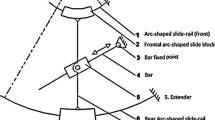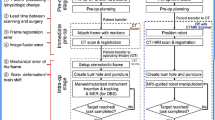Abstract
Purpose
Brain tumor (e.g., glioma) resection surgery, representing the first step for many treatments, is often difficult and time-consuming for neurosurgeons. Thus, intelligent neurosurgical instruments have been developed to improve tumor removal.
Methods
The concept and robotic structure of intelligent neurosurgical instruments were introduced. These instruments consist of a surgical robot, a master device and operating software. The robot incorporates a surgical motion base and tool manipulator, including a volume control suction tool. Open Core Control software was developed for connecting intelligent neurosurgical instruments through a network connection and integrating the instruments into a system.
Results
Mechanical evaluation tests on the components and a preliminary system evaluation were performed. A phantom model was fixed on a head frame, and a tumor-removal procedure was successfully performed using prototype intelligent neurosurgical instruments.
Conclusion
Intelligent neurosurgical instruments are feasible and suitable for on-going evaluation in practical tasks, including in-vivo animal testing.
Similar content being viewed by others
References
The Committee of Brain Tumor Registry of Japan (2003) Report of Brain Tumor Registry of Japan (1969–1996) (2003) Neurol Med Chir (Tokyo) 43(Suppl):i–vii, 1–111
Hentschel SJ, Sawaya R (2003) Optimizing outcomes with maximal surgical resection of malignant gliomas. Cancer Control 10: 109–114
Lacroix M, Abi-Said D, Fourney DR et al (2001) A multivariate analysis of 416 patients with glioblastomamultiforme: prognosis, extent of resection, and survival. J Neurosurg 95: 190–198
Claus EB, Horlacher A, Hsu L et al (2005) Survival rates in patients with low-grade glioma after intraoperative magnetic resonance image guidance. Cancer 103: 1227–1232
Stummer W, Pichlmeier U, Meinel T et al (2006) Fluorescence-guided surgery with 5-aminolevulinic acid for resection of malignant glioma: a randomised controlled multicentre phase III trial. Lancet Oncol 7(5): 392–401
Guthart GS, Salisbury JK (2000) The intuitive telesurgery system: overview and application. In: Proceedings of IEEE international conference on robotics automation, pp 618–621
Pott PP, Scharf HP, Schwarz ML (2005) Today’s state of the art in surgical robotics. Comput Aide Surg 10(2): 101–132
Goto T, Hongo K, Kakizawa Y (2003) Clinical application of robotic telemanipulation system in neurosurgery. J Neurosurg 99(6): 1082–1084
Morita A, Shigeo S, Mitsuishi M (2005) Microsurgical robotic system for the deep surgical field: development of a rototype and feasibility studies in animal and cadaveric models. J Neurosurg 103(2): 320–327
Sutherland GR, Latour I, Greer AD (2008) Integrating an imageguided robot with intraoperative MRI: a review of the design and construction of neuroArm. IEEE Eng Med Biol Mag 27: 59–65
Nakamura Y, Uchiyama T, Cai CM et al (2008) PWM type amorphous wire CMOS IC magneto-impedance sensor having high temperature stability. IEEE Trans Magn 44(11. Part2): 3981–3984
Tanaka Y, Doumoto K, Sano A et al (2009) Expansion of balloon on soft object and its application to tactile sensor. In: Proceedings of the 2009 JSME IIP/ASME ISPS joint conference on micromechatronics for information and precision equipment, pp 313–314
Arata J, Kozuka H, Kim HW et al (2010) Open core control software for surgical robots. Int J CARS 5(3): 211–220
Arata J, Ikemoto J, Sakaguchi M, Fujimoto H (2007) Development of the surgical motion base system using a parallel link mechanism. In: Proceedings of Asian conference on computer aided surgery, 110076
Arata J, Saito Y, Fujimoto H (2010) Outer shell type 2 DOF bending manipulator using spring-link mechanism for medical applications. In: Proceedings of international conference robotics and automation (ICRA), pp 1041–1046
Tada Y, Sano A, Hayashi Y et al (2010) Extirpating brain tumor using a volume controllable suction tube. Int J CARS 5(Suppl 1): S257–S258
Arata J, Terakawa S, Fujimoto H (2009) Development of a back born shape allay force sensor using fiber optic. J JSCAS 11(3): 344–345 (in Japanese)
Arata J, Kondo H, Sakaguchi M et al (2009) Development of a Haptic Device “DELTA-4” using Parallel Link Mechanism. In: Proceedings of international conference robotics and automation (ICRA) 2009, pp 294–300
Tokuda J, Fischer GS, Papademetris X et al (2009) OpenIGTLink: an open network protocol for image-guided therapy environment. Int J Med Robotics Comput Assist Surg (2009). doi:10.1002/rcs.274
Gering D, Nabavi A, Kikinis R et al (1999) An integrated visualization system for surgical planning and guidance using image fusion and interventional imaging. Int Conf Med Image Comput Comput Assist Interv 2: 809–819
Open Core Control software (2010) http://svn.na-mic.org/NAMICSandBox/trunk/IntelligentSI/Control/
Author information
Authors and Affiliations
Corresponding author
Rights and permissions
About this article
Cite this article
Arata, J., Tada, Y., Kozuka, H. et al. Neurosurgical robotic system for brain tumor removal. Int J CARS 6, 375–385 (2011). https://doi.org/10.1007/s11548-010-0514-8
Received:
Accepted:
Published:
Issue Date:
DOI: https://doi.org/10.1007/s11548-010-0514-8




